"Film documents the Royal Visit of King George VI and Queen Elizabeth in Toronto May 22, 1939. Film shows the royal party traveling through the city and at various locations including Union Station, City Hall, Queen's Park, and Exhibition Place. The Toronto Movie Club presents the film, which was shot by over 25 club members staged at different locations. "The Toronto Movie Club : Its first fifty years, 1934-1984" pp. 14, 15, provides additional details about this film including the fact that many copies of the film were sold and one copy was presented to the King and Queen." Archives of Ontario.
"Un-staged documentary footage shot and edited by Sallie Wagner. Sallie's description of the film: 'Trading post at Wide Ruins, "Trader Burnt Hat" - Bill Lippincott, Sallie, Antoinette Badgley - mother, baby, Sallie, group of three left to right - Gaddy, John Joe, and ? , Tom Big Gun - raising his arm quickly Hosteen Belahi. Little Woman - captive of [Kit] Carson [survived the Long Walk and Navajo incarceration at Ft. Sumner], John Joe's wife (gold skirt) and daughter, Mary Toddy and John Toddy, young children, Joe Toddy, Nashoshi Begay, Paul Jones in trading post trading with Bill Cousins, wife and child of Tom Big Gun, Lukachuka - also captive of Carson (Blackrock's brother - both medicine men). Navajo Refugee Site "Kinazin" (which means Standing House) near Wide Ruins, Pat Norton inside "Kinazin" ruins, Cliff Ruin in Canyon del Muerto, ceremonial jar washed out by rain, Bill Lippincott - Elvin Jonas and Jack Norton excavating the pot, climbing cliff at Canyon de Chelly - Larry Bell and Doyle Mulligan, Sallie and Bill looking at pictographs below Wide Ruins, pictographs near spring north of trading post, Navajo Fence at Wide Ruins, numerous sunsets'." New Mexico State Archives.
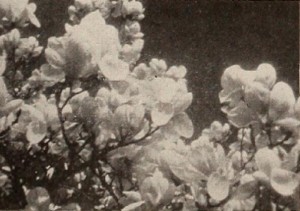
"It is spring in Brooklyn, and Leo J. Heffernan has found a multitude of trees there. He opens the film with a sombre shot of New York's waterfront and skyline, to indicate the tense activity of a large city. A title suggests that those who live in the midst of this turmoil can find solace not far away. The film proceeds to the bounteous display of flowering trees in a large public park. Glowing shots of heavily laden branches against blue sky are interspersed with scenes of Sunday strollers wandering through shaded walks and falling petals. Mr. Heffernan has used to good effect his fine technical skill, and his color transitions between scenes are smoothly accomplished. Trees That Grow in Brooklyn is accompanied by a rhymed narrative written especially for the film by Mr. Heffernan." Movie Makers, Dec. 1946, 489.
"In Two Weeks, W. W. Champion has contrived that rare and refreshing thing — a personal record picture implicit with general human interest. Telling the story of a fortnight's pack trip with friends through Yosemite, the film gets off to a flying start with a delightfully detailed sequence of camp preparations. With complete naturalness, we are made acquainted with each of the vacation party. When, in good time, they set off down the trail, we feel quite sure that these people will prove of more interest than the locales that they will visit. Mr. Champion does not disappoint us, as he continues with an adroitly spun pattern of personalities and places. Crisp, steady and effectively angled, the photography of the film, in both monochrome and color, is of able assistance to the imaginative treatment." Movie Makers, Dec. 1936, 542.
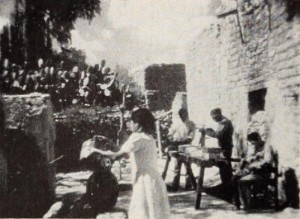
"The vivid pageantry and somnolent landscapes of Mexico assume a new grandeur as filmed by Ralph E. Gray, a cinematographer who has long been recognized as one of the most accomplished amateurs on the continent. The land of contrasts and contradictions is beautifully presented in Typical Times in the Tropics, for here is one of the few travel films that ignore the tourist penchant for flashy trivia, to reveal the spirit of a people and the pictorial splendor in terms of lasting values. Mr. Gray has lived in Mexico long enough to recognize what is really significant; consequently, his film — for all its 1400 feet — seems to be a distillation of the unique charm which continues to attract Americans on vacation. The Mexican's strange blend of religious sincerity and garish ceremony is evidenced in a ritual filmed in Cholula, in which the local livestock — besmeared with gaudy paints and dyes — are presented for the blessing of the village priest — to insure the animals' fertility. The bouganvillea and hibiscus that frame the vistas of sleepy Fortin are contrasted with a boisterous Cuernavaca carnival and the hard riding charros of Mexico City. The latter scenes give Mr. Gray an opportunity to display his technical prowess at its best, for his handling of exposure problems in filming sombrero shadowed faces, his revealing closeups of spectators and skillful following of the wild horses and steer roping are proof of his stature as one of our finest amateur filmers. One of Mr. Gray's most valuable assets is a keen eye for detail, whether it be in the embroidery of a shawl or the weird sculpture left in the path of a lava flow. Intelligent use of a polarizing filter heightens the tawny stuccos of the cathedrals and intensifies the architectural detail of the facades and bell towers; and a fine feeling for human interest gives his shots of a Tehuantepec celebration, the Tirada de Frutas, an added opulence. The cliff divers of Acapulco staged some hairbreadth scenes for Mr. Gray, and he has made the sequence even more breathtaking by cutting in shots of the rocky hazards which had to be cleared by these young daredevils. Saving his trump for a fiery finale, this second time Maxim Award winner winds up with a series of frames of Paricutin, smouldering under her own gray vapors. Sustaining interest throughout 1400 feet of film is no mean task, even when abetted by the natural resources of Mexico; but Mr. Gray has met his challenge with a maximum of taste, discrimination and a completely craftsmanlike approach to a subject that has seldom been presented with such polish and vitality." Movie Makers, Dec. 1946, 470-471.
"Under the Maple Leaf, by Hamilton H. Jones, ACL, is a partially refilmed and entirely reedited version of last year's award winner, Canadian Capers. A splendid picture a year ago, its new and additional sequences now bring to the film a photographic beauty plainly of the very first rank. A sequence of the morning mist rising from a lake deserves particular mention. Mr. Jones's considerable skill with his camera has increased in stature and may not yet have reached its full flowering. For this accomplishment his work has been given a place of honor in these selections. In the reluctant estimation of the judges, however, the editing and cutting of Under the Maple Leaf so far lagged behind its generally matchless beauty as to rob the film of its fullest emotional power. This factor only prevented Mr. Jones from repeating this year his full triumph of a year ago." Movie Makers, Dec. 1933, 523-524.
"Under the Maple Leaf, a new version of the perennial Canadian travel study by Hamilton H. Jones, ACL, is more beautiful and even more satisfying than its forerunners. Ineligible for current Ten Best, because of the fact that a small part of the present material has been viewed and listed in previous selections, the new release is included in the Honorable Mention category as a tribute to the dexterity with which the material, old and new, has been combined and the high quality of the added color sequences. The same flawless photography and clever sequencing which marked previous versions are again present. The disc sound accompaniment (in revised form) is deftly handled, making a thrilling addition to the film. Color is interspersed successfully with black and white sequences in a way that seems to obviate criticism of the mixture." Movie Makers, Dec. 1935, 553.
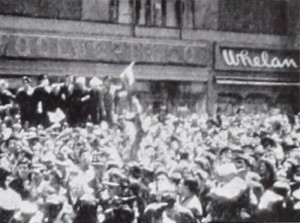
"How shall we film the almost unfilmable — when the world's greatest city goes mad with victory? How, even more, can we film it, when we lack the trucks and vantage points of the newsreel men? F. Clark Tufaro, in Victory Celebration, gives an outstanding and successful answer with his record of New York City's community frenzy, when Japan gave up. He goes from the heart of Times Square to Little Italy, Chinatown and other quarters, everywhere finding something interesting and something that he could actually film, in spite of pushing crowds. He adds fine footage of the welcome to General "Ike" and to General Wainwright and something of the celebration when Germany capitulated. With surprisingly good cinematography, in view of the difficulties. Mr. Tufaro's film is a miracle of persistence, patience and intelligence — and a thoroughly interesting movie." Movie Makers, Dec. 1945, 497.
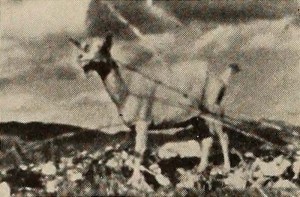
"Vida Pacoima, a two reel study of Mexican life in the southern California village of Pacoima, by Randolph B. Clardy, represents a near miracle in portraying a mood in motion pictures. Whether one likes (i.e., is entertained by) the film or not, there is no gainsaying the amazing emotional effect of its intelligent and beautiful cinematography. Here, in easy going and seemingly unstudied sequence, is the utter aimlessness of the slatternly village and its defeated people. Chickens and children, billy goats and black gowned old women, these are the life of Pacoima. Mr. Clardy has caught them all—either dreaming or drowsy in the sunshine—and presents them with a telling reiteration against the background of their broken homes and through the slats of their sagging fences. A sensuous delight, the photography is as nearly perfect as circumstances would permit, outstripped only by an unerring and often ineffable sense of motion picture continuity. In Vida Pacoima, Mr. Clardy is an artist to his finger tips and a movie maker down to the ground." Movie Makers, Dec. 1938, 617.
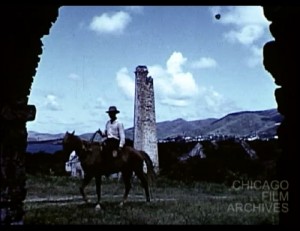
Travelogue exploring the history, sights, and people of the Virgin Islands.
Total Pages: 18